After leaving Omaha Beach, our next stop was the Normandy American Cemetery and Memorial on the cliffs overlooking the beach.
The cemetery was built on the battlefield of Saint Laurent and holds the remains of 9,388 American troops who died in Normandy during World War II.
The cemetery is maintained by the American Battle Monuments Commission and gets over a million visitors a year. It was one of the most crowded sites that we had seen in Normandy so far, with the carpark completely full.
The cemetery has the graves of the Niland brothers (Robert and Preston), who were the basis for the movie Saving Private Ryan, as well as several medal of honor recipients, including President Theodore Roosevelt's sons Theodore Jr and Quentin Roosevelt.
The cemetery forms a Latin cross, housing 10 plots, a chapel in the center and a memorial and Wall of the Missing at the bottom.
The sheer number of graves and crosses really made clear the amount of lives lost and was a humbling experience.
 |
| Pool and marker at the visitor center |
 |
| Heading towards the memorial and cemetery |
 |
| Wall of the Missing and "Spirit of American Youth Rising from the Waves" |
 |
| Looking towards the Chapel from the Wall of the Missing |
 |
| The Chapel |
 |
| Chapel Roof |
From the American Cemetery we drove to Arromanches-les-Bain, which was the site of one of the two temporary "Mulberry" harbors. One of the main concerns for the allies was how they were going to unload the troops and materiel needed for the invasion without access to a port. The precursor to D-Day was a raid on Dieppe to capture a port on the European mainland. The raid failed due to the strong defences of the port and the difficulties unloading troops and vehicles. Without the ability to capture a port (which the Germans had turned into defensive fortresses), the allies needed a way to unload transport ships - the requirements were that the ships needed sufficiently deep water as well as cranes and transportation for the goods.
The Mulberry docks were an idea of Winston Churchill - they would be prefabricated in England and towed across the channel to be installed in Normandy. The harbor would consist of Bombardons (a floating breakwater), Corncobs (static breakwaters) and Phoenix Breakwaters (concrete caissons). As well as floating piers and roadways (whales and beetles) and pier heads (spuds).
The Phoenix Breakwaters were created in Britain and sunk to hide them from the German forces, just before D-Day they were refloated (hence the phoenix name) and towed to Normandy.
The 'corncobs' were ships that were sunk in the habor to create breakwaters - creating a sheltered patch of water nicknamed 'gooseberries'.
The bombardons were 61m x 7.6m floating breakwaters made from steel and rubberized canvas that were tied together to form an outer breakwater.
There were two mulberries created - one at Arromanches, (started on the 8th of June) and one at Omaha beach (started on the 9th). Both harbors were almost complete by the 19th June, when a storm destroyed the harbor in Omaha, leaving it damaged beyond repair.
The Arromanches harbor remained intact and was named Port Winston. It was in operation for eight months and offloaded over 2.5 million troops, 500,00 vehicles and 4 million tons of supplies. Part of the Arromanches mulberry was still visible and this was what we were aiming to see.
The line of blocky barge-like items were the phoenixes still surviving. The scale of the dock was amazing:
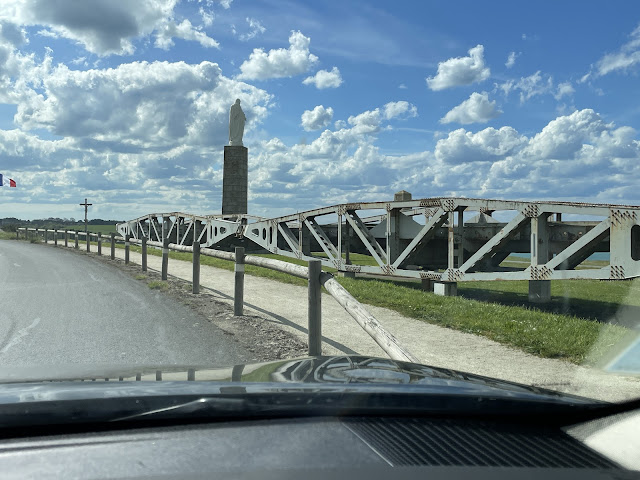 |
| A segment of the roadway used on the mulberry |
Our next stop was Gold Beach. This was the middlemost of the allied landing beaches, and one that was taken by the British Army. The plan was to secure the beach and then capture Arromanches and meet up with the forces at Omaha Beach to the west and Juno to the east as well as capturing the city of Bayeux.
The site was subject to a sustained naval bombardment which managed to disable three of the four guns at the Longues-Sur-Mer battery, but the Le Hamel Strongpoint surived the initial attacks and was eventually destroyed by the Armoured Vechicle Royal Engineers.
The beachhead was established on the first day and the infantry moved to clearing the fortified houses. The Number 47 Commandos captured Port-en-Bessin and the 1st Battalion captured Arromanches. Bayeux was captured on the 7th of June. Of the 24,970 men landing on D-Day, there were 1000-1100 allied casualties, including 350 killed.
Gold Beach was home to the British Normandy Memorial, which was opened in June 6th, 2021 on the the 77th anniversary of the landings. The names of 22,442 British (and British controlled colony) deaths in Normandy are recorded on the monument.
 |
| Metal silhouettes of soldiers line the beach |
Our next stop was Juno Beach, the fourth of the five beaches - this one captured by Canadian troops. The beach was originally going to be codenamed Jelly (each of the British beaches was named after a fish - Sword(fish), Gold(fish) and Jelly(fish)), but Churchill deemed that Jelly was inappropriate a name for a beach where soldiers would be killed, so changed the name to Juno.
The Canadian 1st Infantry Division, 1st Armoured Brigade and 1st Commando Battalion landed with support from British transport, naval bombardment and mine sweeping. there were 961 allied casualties, including 340 killed.
The plan was for the Canadians to secure the beach and then move inland, joining with Sword and Gold Beach forces to capture the Capiquet Airfield and the Caen-Bayeux Railroad.
We stopped briefly at the Juno visitor center to get some photos:
Our final stop of the day was Sword Beach, the eastern most of the D-Day beaches. The plan for Sword beach was for the British Second Army I Corps to secure the beach and then the city of Caen.
28,845 men landed at Sword beach on D-Day and there were 683 allied casualties. The forces were not able to press on Caen initially, but the next day they linked with forces from Juno Beach and were able to push on to Caen. The city was well defended and was only captured twelve days later.
One of the most popular stories of Sword Beach, was that of Piper Bill Millin. Piper Bill was the personal piper for Commander Simon Fraser (15th Lord Lovat) who landed on Sword beach in D-Day. During the landing Piper Bill played his bagpipes even during the heaviest of fighting. Stories say that German snipers had sighted him but refused to shoot because "they believed he had gone mad."
By now it was getting late and we had an hour and a half drive back to our apartment. We hadn't had chance to do any shopping to get food for breakfast, and now unfortunately most of the stores were closed, so we had to detour even further into Cherbourg in order to find a small store that was open. By the time we got back to the apartment we were exhausted and fell asleep pretty quickly.


































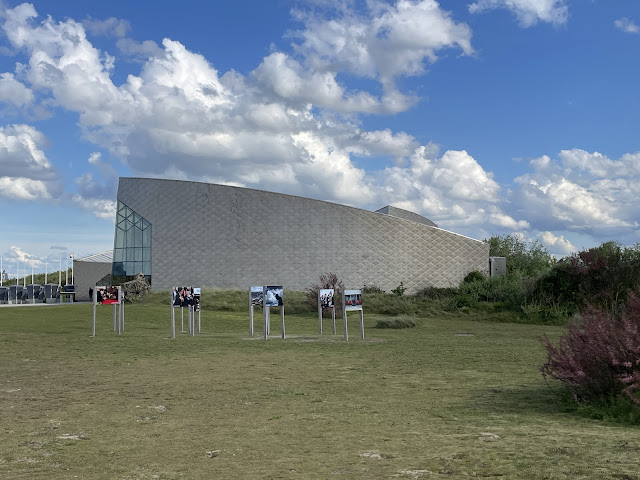

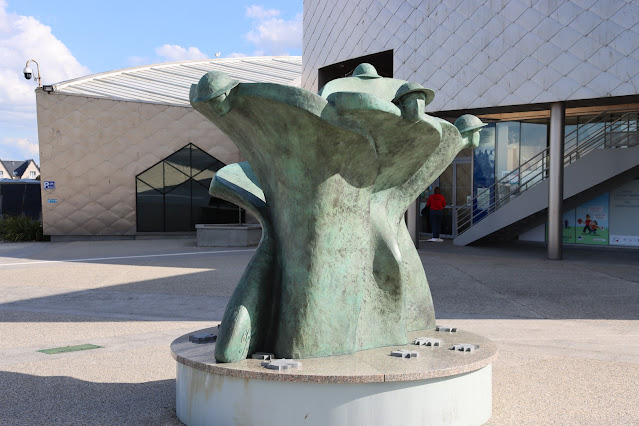



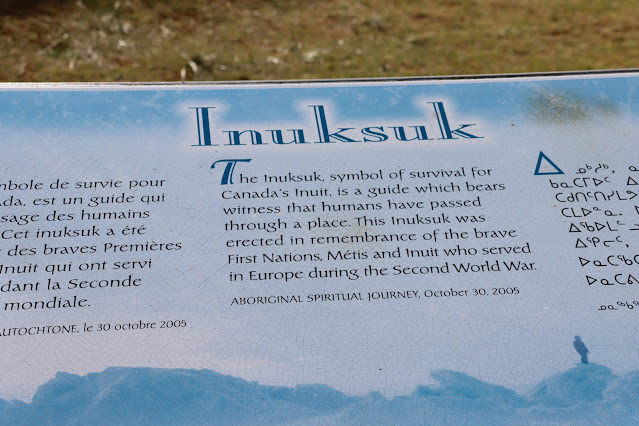
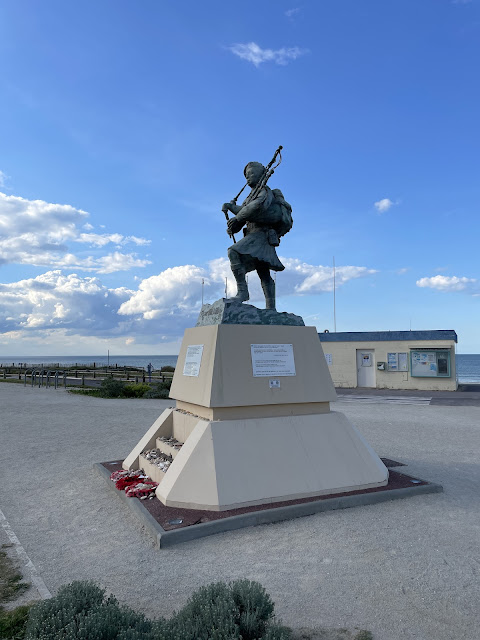





No comments:
Post a Comment